The Red Special Strat was pretty damned good with the American Professional neck but this came up on eBay and I just had to throw money at it. This is a Fender "Ultra Luxe" neck with a compound radius and black headstock, factory Fender locking tuners and ebony board.
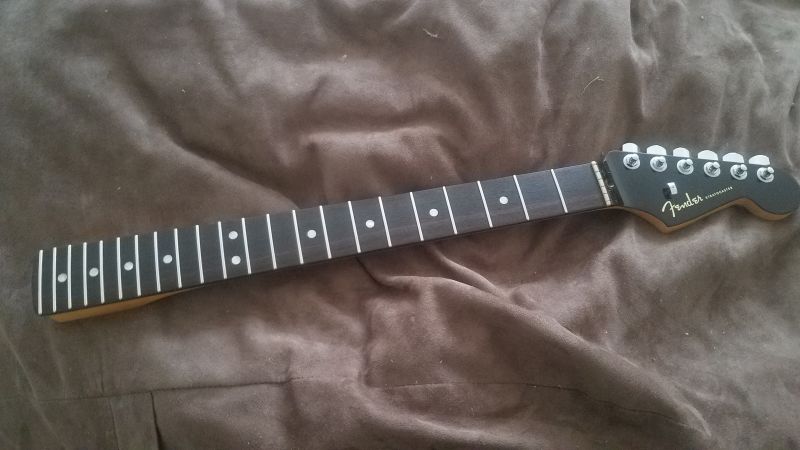

The red, white and black colour scheme looks stunning and the setup is just spot on with a low action and 09 to 42 strings. It'll need some tweaks as the neck settles in but I'm very happy with how this turned out and the Red Special is one of my very finest partscaster builds.
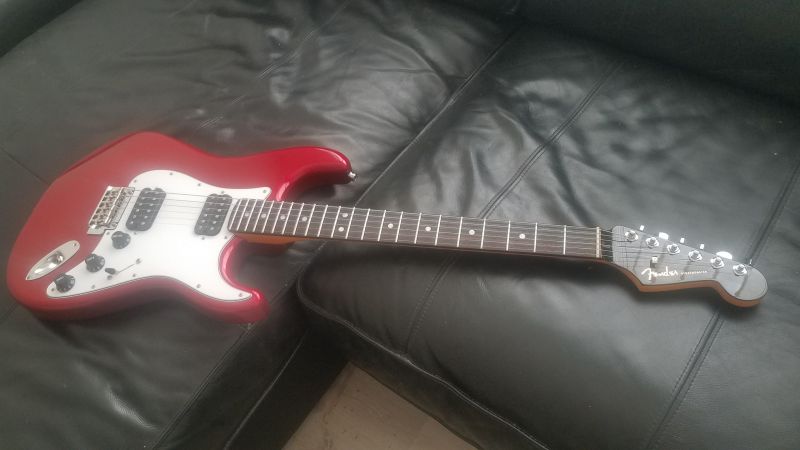
The only thing I'm tempted to do now is to refret it with big stainless steel frets but that's a job for another day.
Quick mention for the neck pickup that just arrived for the Red Special build, a mean-looking DiMarzio Air Norton from those lovely folk at Andertons Music. I'm still waiting for the pickguard to arrive so the project's stalled at the moment but I can't wait to get a double-humbucking Stratocaster together.

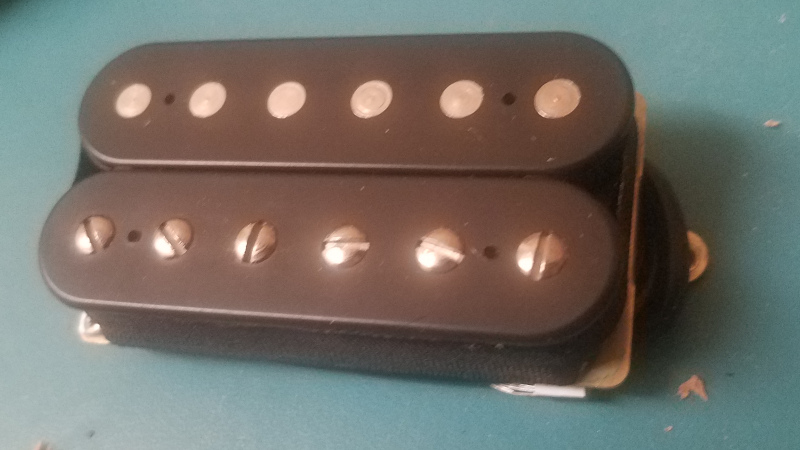
Caution: contains major spoilers for anyone who hasn't seen Chapter 1.
With a bit of careful drilling and filing and a tiny bit of routing the Roland GK pickup is bolted in place and the MG510 is starting to look pretty mean.
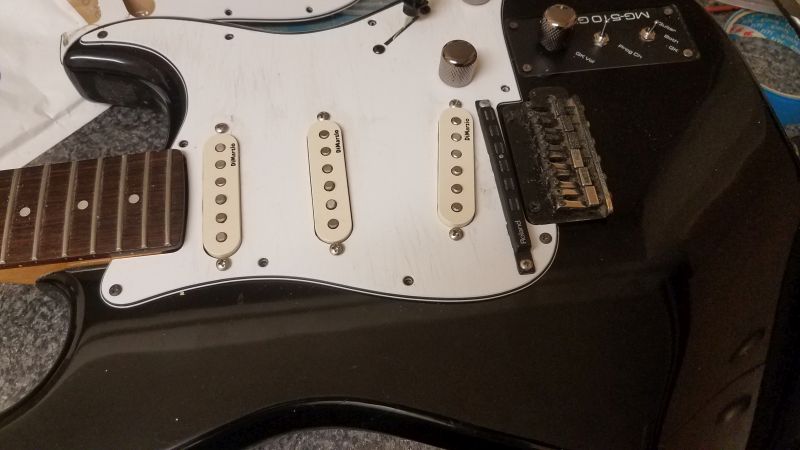
Now it's electronics time. Installing the GK control board and wiring all the controls can be a tricky operation with much potential for stripping wires too short or pulling them out of the multi-pin headers. Proceed with caution.
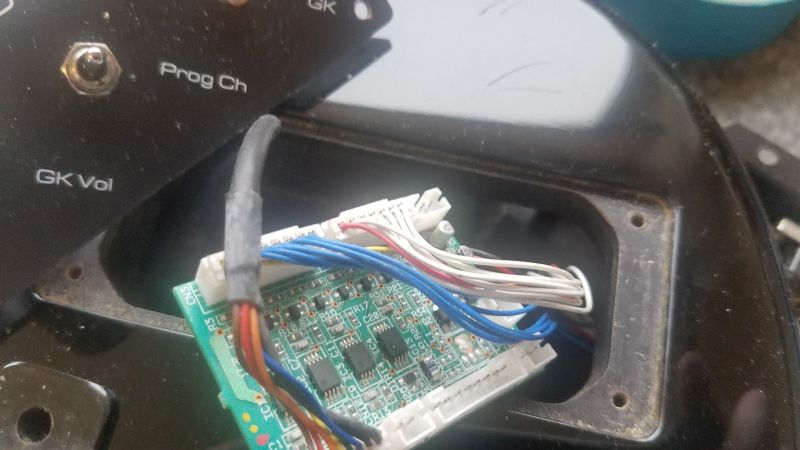
The great thing about the Casio guitar is the amount of space they routed out for all the MIDI converter circuitry leaving plenty of room for the tiny GK board. Fitting this into a standard Stratocaster is next to impossible without routing chunks of wood away but this is an absolute breeze.
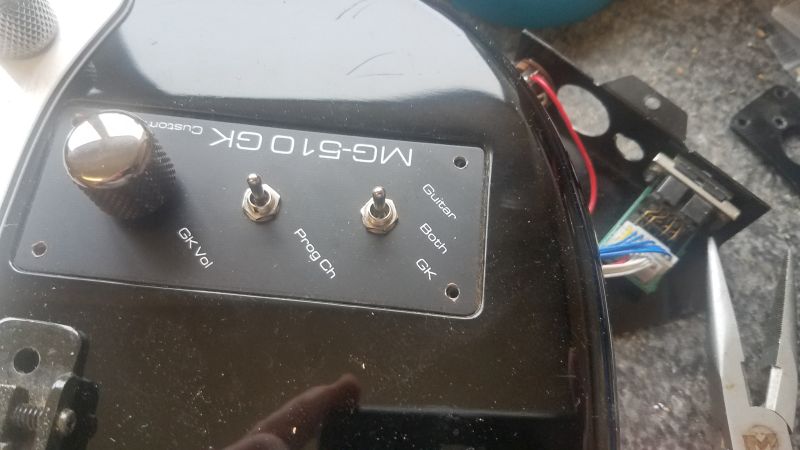
To make life even easier, the GK output jack fits absolutely perfectly into the hole in the jack plate where the MIDI output used to be. Unfortunately there are some redundant openings that may or may not get a blanking plate some time in the future.
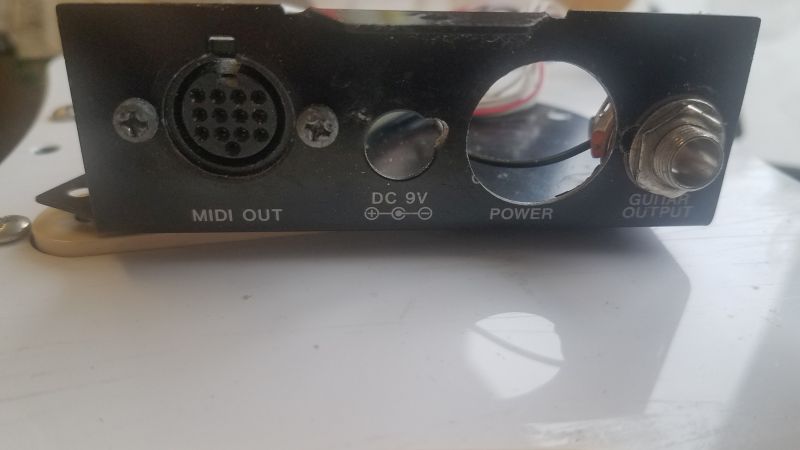
In this operation it is absolutely vital to refer to the GK-Kit installation guide and its Japlish advice on how to wire the "buttery" in an active guitar.
GK-KIT-GT3_OM.pdf (683.34 kb)
To be continued ...
"All I ever wanted was a red electric guitar ..."
This is something I've wanted for a very long time, a Stratocaster in metallic candy apple red. I've had the Fender Deluxe neck lying around for a while and the time just seemed right to build it into a guitar. The body is another Fender Deluxe part, one of the bodies they sell to people like me who feel the need to hammer guitars together from parts.

Looks a bit Hank Marvin's Stratocaster but it's certainly not going to sound like Hank.

First job was to check the neck fit and it really is absolutely perfect. Fender seem to have taken CNC milling of guitar parts to an even higher level than I had previously thought, this is absolutely flawless.

Tremolo spring install is a fiddly job, be careful not to slip and run the pointed head of the screwdriver across that beautiful finish!
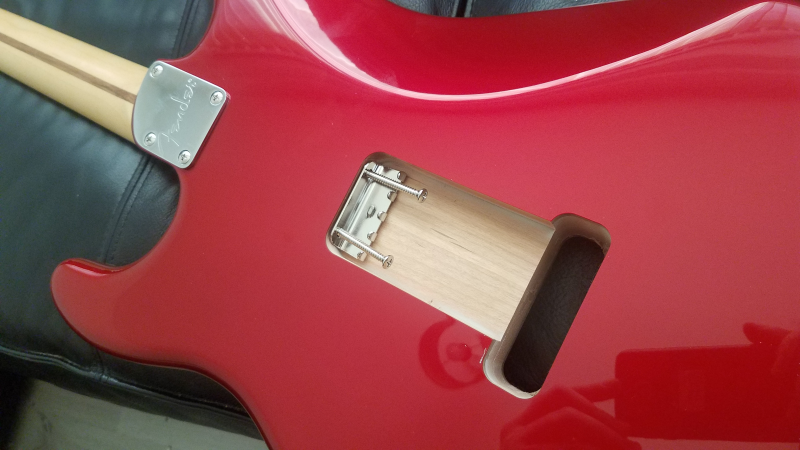
Bridge stud install is even worse though. Hammering these brass inserts into the body while trying not to slip and hammer the top of the guitar is nerve-wracking to say the least. Despite what these photos suggest, I did eventually get them both seated equally.
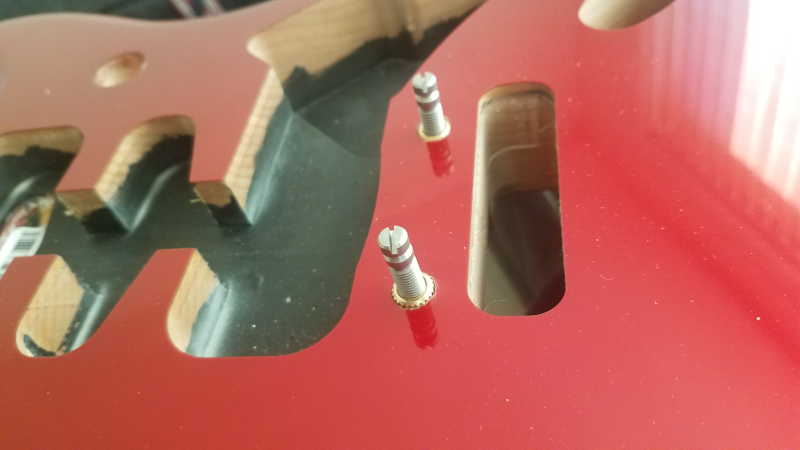
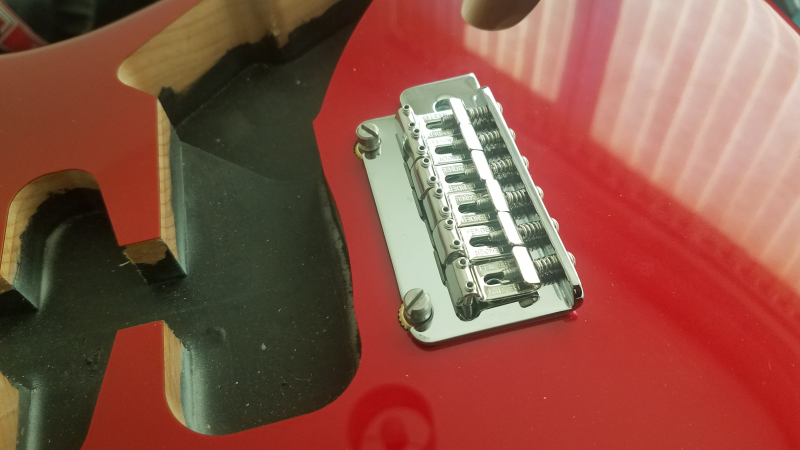
The "Red Special" Stratocaster is going to feature two humbuckers. In tribute to one of my first guitars I've gone for a Seymour Duncan Custom Trembucker in the bridge as I know this pickup has a fairly smooth clean and crunch sound as well as enough grunt to really drive an amplifier. Neck pickup will be a DiMarzio Air Norton when I've recovered from the financial shock of building the guitar this far.
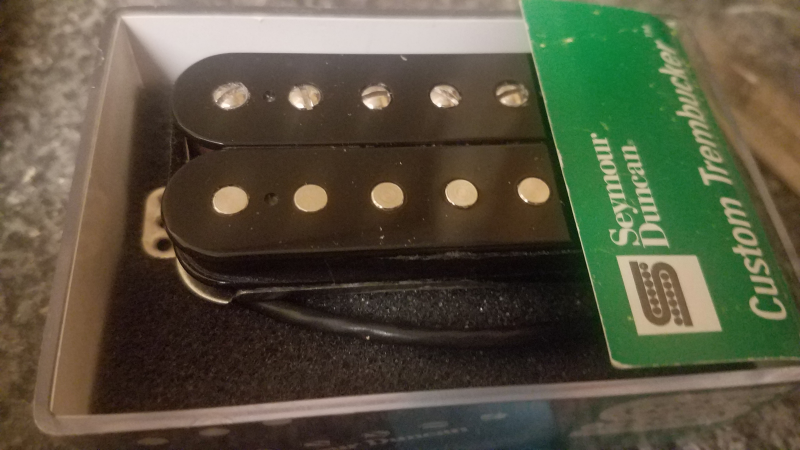
Still got to order about £160 worth of parts and pickups but it looks good even with an old smoke-stained pickguard with the wrong pickup spaces.
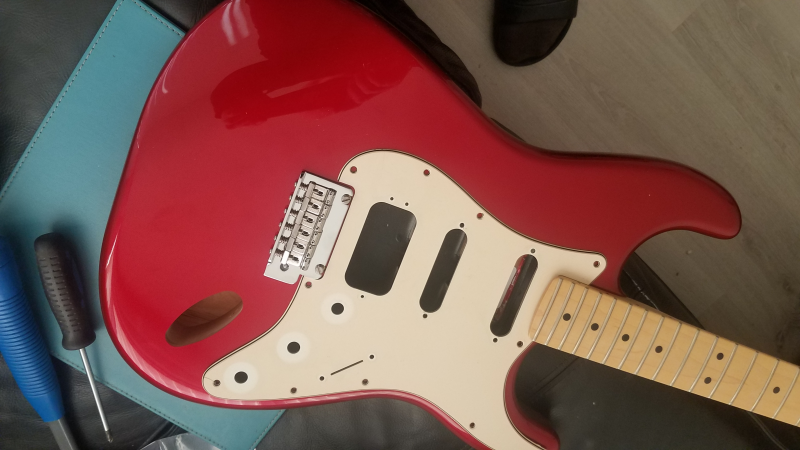
This will be a beast of an instrument. I'm even thinking of breaking with tradition by fitting 09 gauge strings and making the tremolo float. I always hardtail my Stratocasters to allow for double-string bends but I imagine this one will be mostly for power chords and single-note riffs so I might as well have a bit of fun.
Unfortunately this project is delayed for several weeks while I wait for a custom pickguard to arrive from WD Music. Stay tuned for more updates.
Update: My DiMarzio Air Norton arrived. Still waiting for businesses to wake up for the new year but the pickguard is on order.
The time has come to do drastic surgery on the non-functioning Casio MIDI guitar. While the 1990s output of the Fuji-Gen Gakki factory has superb build quality, I've never been a fan of the Japanese pickups. I happen to have a nice set of DiMarzio noiseless single coils that would suit this guitar very nicely and a Roland GK kit so let's get to work ripping out the old electronics ...

The MIDI control panel isn't entirely suited to the GK controls so I've rattled off a PCB design with a GK volume control, momentary up/down program change switch and a GK/guitar/both selector.

Custom pickguard by local builder Tiny Tone is a hybrid of the old Casio version and a US Stratocaster with three single coils instead of the Casio HSS layout. The MIDI pickup isn't compatible with the GK board so the bridge cutout is Stratocaster style.

I've installed a four-pole double wafer switch as I want this guitar to have my special custom switching.
Super Strat Wiring.png (opens in new window)
So that's all the best Stratocaster sounds plus the Telecaster inbetween sound. The noiseless pickups should be perfect for this as there's no problem with not having RWRP in some combinations.

Next job will be drilling the pickguard for the GK pickup.

I've routed a lot of wood away around the bridge and I'll be using a pickguard from another project as a drilling template. This is an after market pickguard for a Fender Roland Ready Stratocaster and the GK pickup holes line up exactly with the Roland unit.

Don't miss the thrilling Chapter 2
This is the latest nightmare of wires and microcontrollers, my MIDI pedalboard controller to route clock and program change round the two pedalboards. When (if) finished it will (should) allow me to use the RC-500 Loop Station as a master MIDI clock for all the pedals while receiving program change from the BOSS GP-10. Those program changes select a "super patch" from SD card on a LOLIN D32 Pro ESP32 MCU which selects different program changes for the three Eventide pedals.
I originally planned this with a web interface using ESPAsyncWebServer and JSON but that's been scaled back due to lack of available memory but it may just expand into a second ESP32 board to provide Wifi connectivity and web front end. A work in progress.
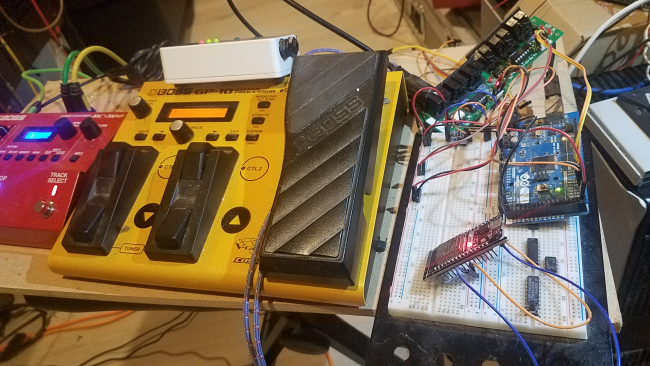
Made this today for a friend who's going to see Nile Rodgers in December, I thought it would be good to pre-empt the occasion by dusting off a few of my favourite guitars with one of my favourite riffs.
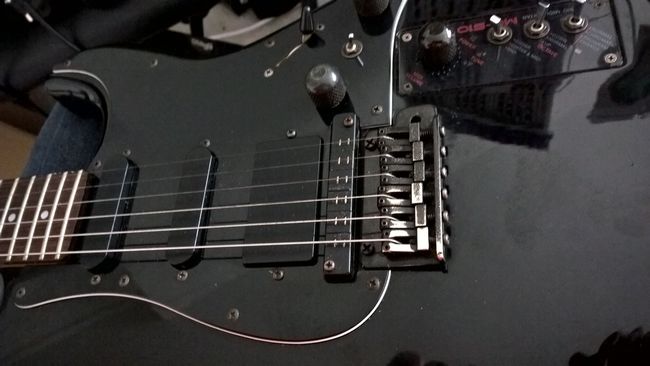
Yes, it's another new (old) guitar. This one has been a "Holy Grail" guitar for me for a long time. I used one back in the 1990s in a studio in Newcastle and I always remembered it being a great guitar. Turns out they were built for Casio in the Japanese Fuji-gen Gakki plant that made the Japanese Fenders of the 1980s and the neck contour is exactly the same as my E-series MIJ Stratocaster.
Unfortunately, someone's done amateur repairs to this and soldered it up with jam and a hot spoon so the MIDI circuit is dead as a doornail and not coming back. No matter, I may even retrofit a Roland GK kit into this and have the world's coolest 90s tech guitar.

UPDATE: Currently undergoing conversion to a Roland GK system
This is an interesting Fender oddity, a Mexican Stratocaster body with a USA made neck and incorporating Roland's GK hex pickup to drive guitar synths and processors like the GP-10 or the VG-99.
The GC-1 had a fairly short production run in the early 2000s and is out of production now, probably due to the apparent reluctance of guitar players to fully embrace hex pickup technology. This is a pity as it is capable of stunning effects that can't be achieved on any other guitar such as baritone guitar, 12-string simulation and programmable pitch shift per string which allows for alternate tunings at the press of a button. The GP-10 also lets you do string bends from a footpedal, creating impossible multi-string bends and pedal steel effects.
Here's the GP-10 and GC-1 doing some of that stuff. First off, the GP-10 is set to play an open E minor chord and the expression pedal bends strings up and down to make an open A minor chord. Hit a few harmonics and the thing warbles into a sound vaguely reminiscent of a pedal steel but with a far more modern edge to it.
It does straight tuning transpose too, here's a baritone guitar effect.
And it's handy for recording demos if you can't be bothered to pull more than one guitar off the stand. This is the GC-1 standard magnetic pickups mixed with the modelled sounds to provide electric, acoustic and 12-string sounds as well as an open G slide part.
The latest (and probably last) guitar arrival is ... yet another Stratocaster. This is another partscaster, made from a Jeff Beck Strat body with a US Standard neck. Pickups are by The Creamery - a Baby 71 humbucker in the bridge and Alt 64s in the neck and middle positions.
The Baby 71 is the reason I wanted to build this guitar. It's a reproduction of the old Fender Wide Range Humbucker, a really great-sounding low output humbucker with extended highs. Works beautifully with single coil pickups, something like the Fender Shawbucker but with a chiming character all of its own.
This video was shot as soon as I'd thrown the guitar together so the intonation wasn't right and the strings were choking on a few of the bends but you get an idea of how good that bridge and middle sound is.
The Baby 71 and Alt 64s are available from Jaime at The Creamery and highly recommended.